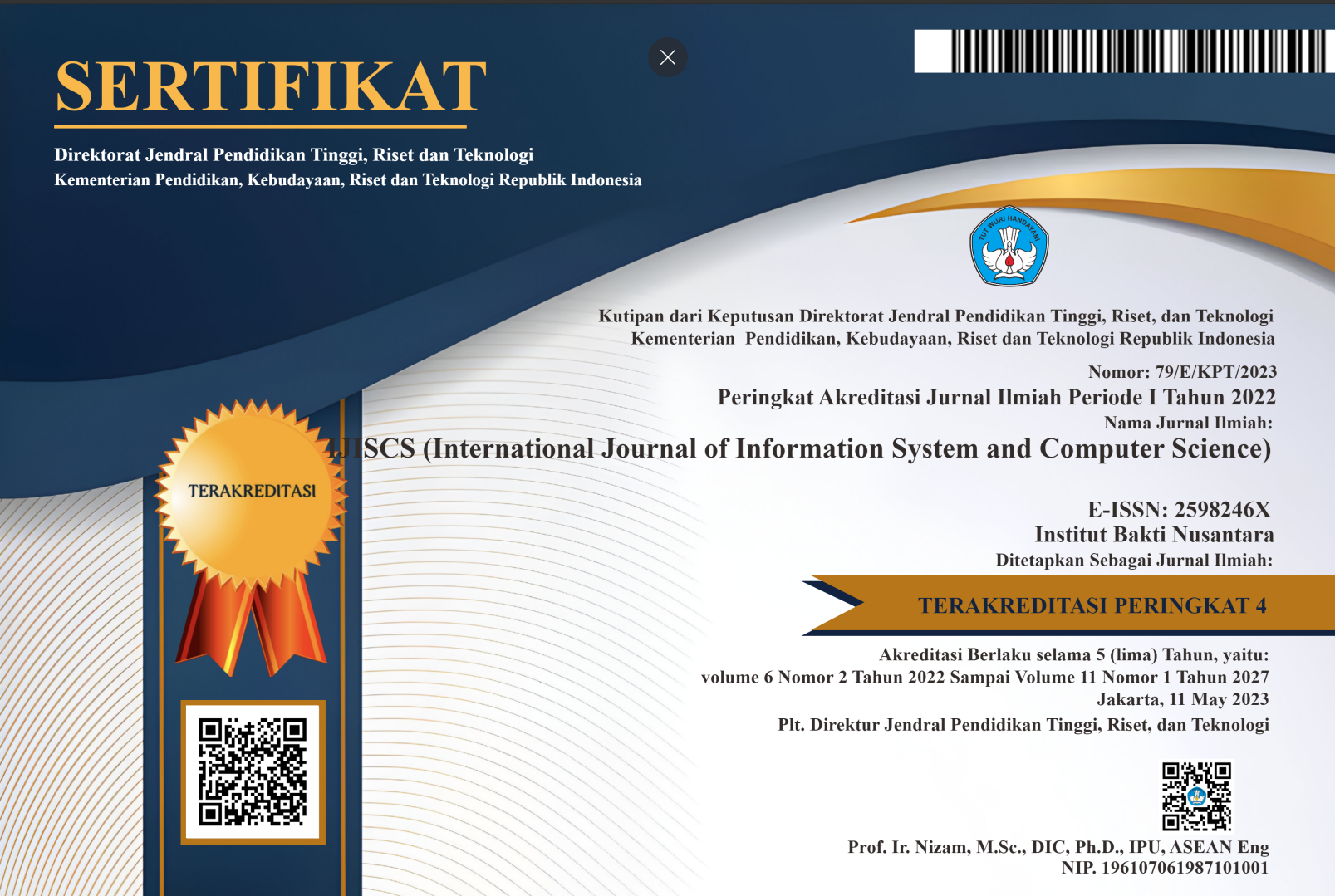OPTIMIZING RISK MANAGEMENT IN THE INSURANCE SECTOR: LEVERAGING THE COBIT 5 FRAMEWORK
(1) Department Information System, Faculty of Engineering and Informatics, Universitas Multimedia Nusantara, Boulevard Raya Gading Serpong, Tangerang, Banten
(2) Department Information System, Faculty of Engineering and Informatics, Universitas Multimedia Nusantara, Boulevard Raya Gading Serpong, Tangerang, Banten
 Corresponding Author
Corresponding Author
Abstract
Keywords
References
F. Salehi, B. Abdollahbeigi, and S. Sajjady, “Impact of Effective IT Governance on Organizational Performance and Economic Growth in Canada,” vol. 3, pp. 14–19, Feb. 2021.
I. Scalabrin Bianchi, R. Sousa, and R. Pereira, “Information Technology Governance for Higher Education Institutions: A Multi-Country Study,” Informatics, vol. 8, p. 26, Apr. 2021, doi: 10.3390/informatics8020026.
W. Santos Castellanos, “Impact of Information Technology (IT) Governance on Business-IT Alignment,” Cuadernos de Gestión, vol. 2020-12–10, Dec. 2020, doi: 10.5295/cdg.180995ws.
D. Smits and J. Hillegersberg, “The development of a hard and soft IT governance assessment instrument,” Procedia Comput Sci, vol. 121, pp. 47–54, Jan. 2017, doi: 10.1016/j.procs.2017.11.008.
A. Nurdin and M. Lubis, “The IT Governance Measurement using Cobit 5 Framework in Quality Assurance Department,” Jurnal Informatika dan Rekayasa Perangkat Lunak, vol. 5, p. 80, Mar. 2023, doi: 10.36499/jinrpl.v5i1.7963.
E. Alsaleem and N. Husin, “The Impact of Information Technology Governance Under Cobit-5 Framework on Reducing the Audit Risk in Jordanian Companies,” International Journal of Professional Business Review, vol. 8, p. e01236, Feb. 2023, doi: 10.26668/businessreview/2023.v8i2.1236.
A. Asmah and M. Kyobe, Towards an Integrative Theoretical Model For Examining IT Governance Audits. 2018. doi: 10.1145/3209415.3209423.
A. Nurdin and M. Lubis, “The IT Governance Measurement using Cobit 5 Framework in Quality Assurance Department,” Jurnal Informatika dan Rekayasa Perangkat Lunak, vol. 5, p. 80, Mar. 2023, doi: 10.36499/jinrpl.v5i1.7963.
H. Nugroho, “Proposed IT Governance at Hospital Based on COBIT 5 Framework,” IJAIT (International Journal of Applied Information Technology), vol. 1, p. 52, Aug. 2017, doi: 10.25124/ijait.v1i02.875.
D. Putri, J. Juwairiah, and F. Kodong, “Capability Level Analysis of IT Governance Using COBIT 5 on Continuity and Availability Of Services (Case Study: LMS Spada Wimaya),” Telematika, vol. 19, p. 283, Oct. 2022, doi: 10.31315/telematika.v19i3.7059.
N. Mutia and R. Nur’ainy, “IT GOVERNANCE: MEASURE CAPABILITY LEVEL USING COBIT 5 FRAMEWORK,” Jurnal Ilmiah Ekonomi Bisnis, vol. 25, pp. 97–110, Aug. 2020, doi: 10.35760/eb.2020.v25i2.2609.
D. Sanjaya and M. I. Fianty, “Measurement of Capability Level Using COBIT 5 Framework (Case Study: PT Andalan Bunda Bijak),” Ultima Infosys : Jurnal Ilmu Sistem Informasi, vol. 13, no. 2, 2022.
A. A. Louis and M. I. Fianty, “Evaluation Human Resources Information System Using COBIT 5 Framework in Technology Insurance Company,” G-Tech: Jurnal Teknologi Terapan, vol. 7, no. 2, pp. 674–682, Mar. 2023, doi: 10.33379/gtech.v7i2.2393.
Y. Bounagui, A. Mezrioui, and H. Hafiddi, “Toward a unified framework for Cloud Computing governance: An approach for evaluating and integrating IT management and governance models,” Comput Stand Interfaces, vol. 62, pp. 98–118, Sep. 2018, doi: 10.1016/j.csi.2018.09.001.
K. Pratama Arthananda, “The Role of COBIT5 as a Reference for Quality Service Quality Improvement Case Study: Private Bank in Indonesia,” Ultima Infosys : Jurnal Ilmu Sistem Informasi, vol. 12, no. 2, 2021.
A. Amorim, M. Mira da Silva, R. Pereira, and M. Gonçalves, “Using agile methodologies for adopting COBIT,” Inf Syst, vol. 101, p. 101496, Feb. 2020, doi: 10.1016/j.is.2020.101496.
A. Tantiono and D. Legowo, “Information System Governance in Higher Education Foundation using COBIT 5 Framework,” International Journal of Recent Technology and Engineering (IJRTE), vol. 8, pp. 2798–2811, Mar. 2020, doi: 10.35940/ijrte.F8192.038620.
F. Muttaqin, M. Idhom, F. Akbar, M. Swari, and E. Putri, “Measurement of the IT Helpdesk Capability Level Using the COBIT 5 Framework,” J Phys Conf Ser, vol. 1569, p. 022039, Jul. 2020, doi: 10.1088/1742-6596/1569/2/022039.
D. Putra and M. I. Fianty, “Capability Level Measurement of Information Systems Using COBIT 5 Framework in Garment Company,” Journal of Information Systems and Informatics, vol. 5, no. 1, pp. 333–346, Mar. 2023, doi: 10.51519/journalisi.v5i1.454.
S. Haes, W. Grembergen, A. Joshi, and T. Huygh, “Enterprise Governance of IT, Alignment, and Value,” 2020, pp. 1–13. doi: 10.1007/978-3-030-25918-1_1.
R. Frogeri, D. Pardini, A. Cardoso, L. Prado, F. Pelloso Piurcosky, and P. Portugal Júnior, “IT Governance in SMEs: The State of Art,” International Journal of IT/Business Alignment and Governance, vol. 10, pp. 55–73, Jan. 2019, doi: 10.4018/IJITBAG.2019010104.
L. Englbrecht, S. Meier, and G. Pernul, “Towards a capability maturity model for digital forensic readiness,” Wireless Networks, vol. 26, pp. 4895–4907, Oct. 2020, doi: 10.1007/s11276-018-01920-5.
S. Saeedinezhad and A. Naghsh, “Management of IT Services in the Field of Pre-Hospital Emergency Management with the Combined Approach of COBIT Maturity Model and ITIL Framework: A Conceptual Model,” 2019.
A. Levstek, T. Hovelja, and A. Pucihar, “IT Governance Mechanisms and Contingency Factors: Towards an Adaptive IT Governance Model,” Organizacija, vol. 51, pp. 286–310, Dec. 2018, doi: 10.2478/orga-2018-0024.
Article Metrics
Abstract View : 75 times
: 75 times Download : 25 times
Download : 25 times
DOI: 10.56327/ijiscs.v7i3.1591
Refbacks
- There are currently no refbacks.






